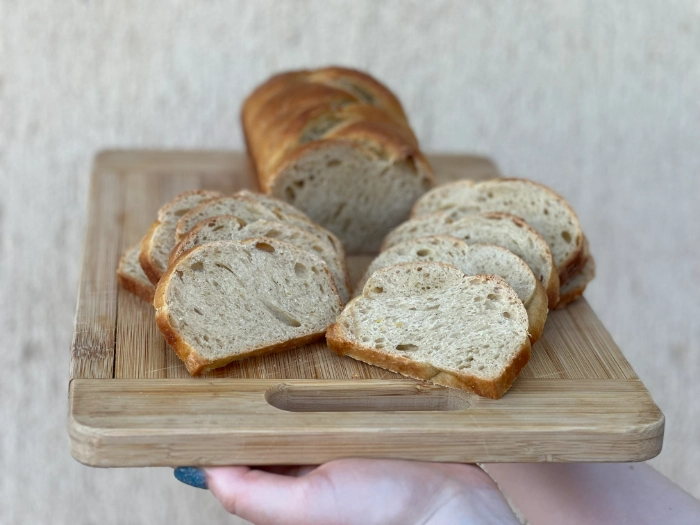Sweet Braided Milk Loaf with Sourdough Starter

-
What Is a Sourdough Milk Loaf?
-
Tools You'll Need
-
Ingredients
-
Method
- Mix the Dough
- Bulk Fermentation with Folds
- Shape the Loaf
- Final Proof
- Bake
-
Serving Suggestions
-
You Might Also Like These Posts
A sweet, braided loaf with a pillowy crumb and deep sourdough flavor? Yes, please. This sourdough milk loaf, inspired by the traditional Hungarian kalács, brings together the elegance of enriched dough and the wholesome strength of wild fermentation.
Perfect for Easter mornings, Sunday brunch, or simply a cozy breakfast with jam and butter, this braided milk loaf offers something special: a soft and sweet taste with the rich aroma only sourdough can provide.
What Is a Sourdough Milk Loaf?
In many cultures, enriched loaves made with milk, eggs, and butter are a holiday staple. Hungarian kalács, often served at Easter, is one of the most beloved versions in Central Europe. Traditionally braided and enriched with sugar, eggs, and dairy, it's a celebration bread.
The version we're making here replaces commercial yeast with natural sourdough starter, giving it a deeper flavor and longer shelf life. The fermentation also makes it easier on digestion - a bonus for those sensitive to yeasted or highly processed baked goods.
Want to know more about this enriched bread family? King Arthur Baking explains what milk bread is and why it's so irresistibly soft.
Curious about the benefits of sourdough? Harvard Health recommends fermented foods like sourdough bread for their positive effects on gut health.
Tools You'll Need
Mixing bowl
Loaf pan (greased with butter)
Plastic wrap or cover for proofing
Ingredients
270 g all-purpose or bread flour
100 g whole milk (room temperature or hand warm)
40 g sugar
1 whole egg + 1 yolk
10 g vanilla sugar (Use it according to taste, or use vanilla extract)
110 g active sourdough starter (fed ~4-6 hours earlier)
8 g salt
50 g unsalted butter (room temperature)
Note: Want to learn how to feed your sourdough specifically for baking?
Method
Mix the Dough
Feed your sourdough the night before. We want it bubbly but not too sour - we don’t want a tangy flavor to overpower the sweetness.
In a large bowl, combine flour, milk, sugar, egg, yolk, vanilla sugar, and sourdough starter. Mix until combined.
Add salt and butter last, and knead thoroughly until the dough becomes smooth and elastic. Let it rest for 20 minutes.
Bulk Fermentation with Folds
Perform four to five sets of folds at 25-minute intervals. Consider using coil folds, which are gentler and work beautifully for enriched, soft doughs. Here’s a folding technique guide.
Shape the Loaf
There are two main shaping options:
Braided milk loaf: Divide the dough into three equal strands, roll each into a rope, and braid them tightly. Tuck the ends under.
You can take it into a loaf pan:
Or you can make it the traditional way:
Simple Roll: Gently stretch the dough out and roll it up into a log, and shape it to fit your buttered loaf pan.
Place the shaped dough into the greased loaf pan.
Final Proof
Cover with plastic wrap (do not touch the dough with it - it'll stick to it) and let proof in a cool place overnight (or at room temperature for 6-7 hours) until visibly risen and jiggly to the touch.
Bake
Preheat oven to 180°C (355°F).
Brush the top with a generous egg wash (whisked egg or yolk) and bake for 25–30 minutes, or until golden brown and cooked through.
Every oven differs, so keep an eye on it. A thermometer inserted should read 94°C (200°F) when fully baked.
Serving Suggestions
Let the loaf cool fully before slicing. It pairs beautifully with:
Fruit preserves or homemade jam
Butter and honey
Cocoa or strong coffee
You Might Also Like These Posts
How to Feed Your Sourdough Starter for Perfect Baking Results
Folding Dough: Why It Matters and How to Do It Right
How to Feed, Maintain, and Strengthen Your Sourdough Starter
-
What Is a Sourdough Milk Loaf?
-
Tools You'll Need
-
Ingredients
-
Method
- Mix the Dough
- Bulk Fermentation with Folds
- Shape the Loaf
- Final Proof
- Bake
-
Serving Suggestions
-
You Might Also Like These Posts


